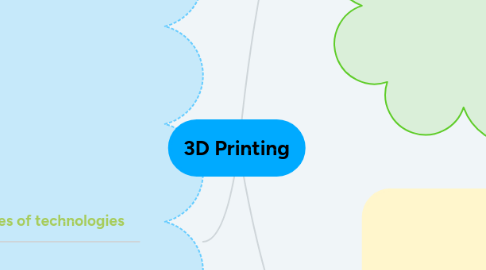
1. Types of technologies
1.1. Vat Photopolymerisation
1.1.1. Stereolithography(SLA)
1.1.2. Digital Light Processing(DLP)
1.1.3. Continuous Liquid Interface Production(CLIP)
1.2. Material Jetting
1.3. Binder Jetting
1.4. Material Extrusion
1.4.1. Fused Deposition Modeling(FDM)
1.4.2. Fused Filament Fabrication(FFF)
1.4.3. Contour Crafting
1.5. Powder Bed Fusion
1.5.1. Selective Laser Sintering(SLS)
1.5.2. Direct Metal Laser Sintering(DMLS)
1.6. Sheet Lamination
1.7. Directed Energy Deposition
2. Applications
2.1. Medical
2.1.1. Prosthetics
2.1.2. Orthopedic surgery
2.1.3. Bio-printing
2.1.4. Dental
2.2. Aerospace
2.2.1. Shielding on shuttles
2.3. Automotive
2.3.1. AM technologies
2.3.1.1. parts
2.3.1.1.1. carbon fiber parts
2.3.1.2. tools
2.3.1.3. interior elements
2.4. Architecture
2.4.1. Physical scale model
2.5. Art
2.5.1. Wood filament
2.5.1.1. musical instrument
2.6. Education
2.6.1. education project
2.6.1.1. prototypes
2.7. Manufacturing
2.7.1. contour crafting
2.7.2. houses
2.7.3. user products
2.7.4. Consumer Goods
3. Advantages & Disadvantages
3.1. Advantages
3.1.1. Complex design
3.1.2. Customization
3.1.3. Less waste produced
3.1.4. cheap to produce
3.2. disadvantages
3.2.1. High cost for 3D printers
3.2.2. Less choices
3.2.2.1. Materials
3.2.2.2. Colours
3.2.2.3. Finishes
3.2.3. Limited strength
3.2.4. Limited endurance
3.2.5. Unemployment

